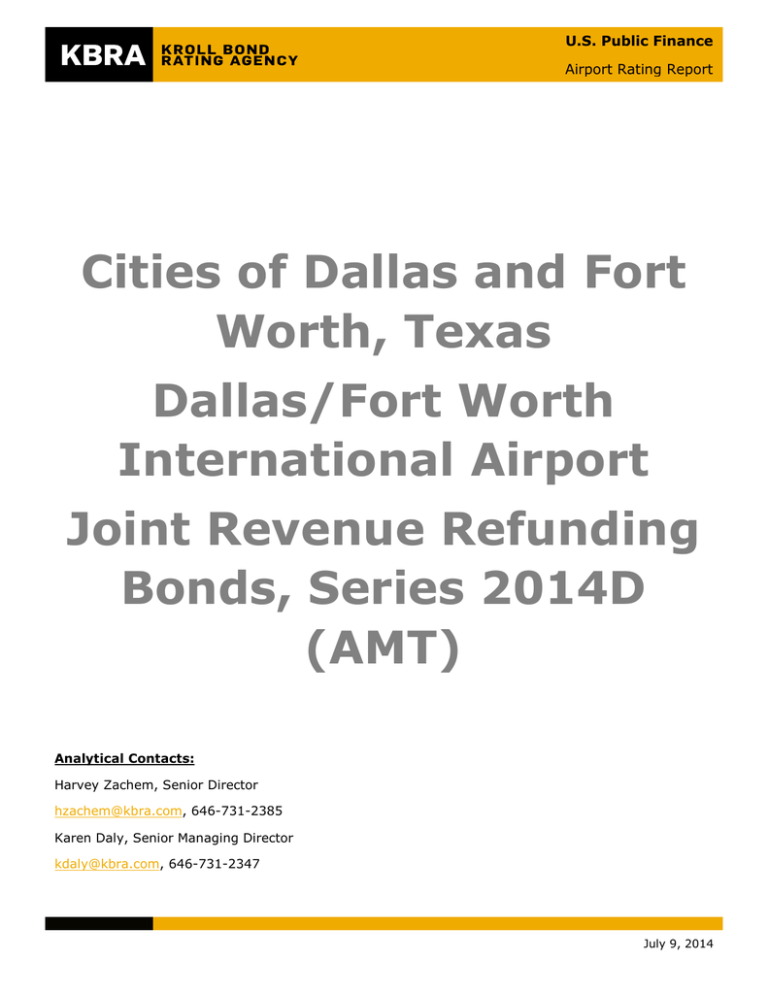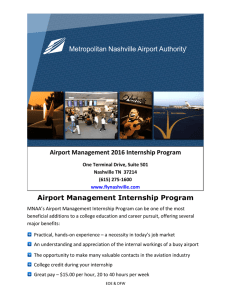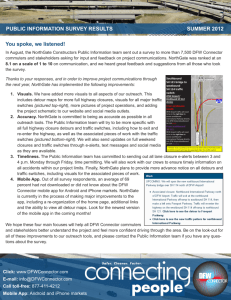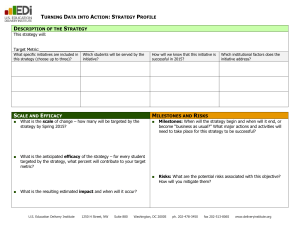
U.S. Public Finance
Airport Rating Report
Cities of Dallas and Fort
Worth, Texas
Dallas/Fort Worth
International Airport
Joint Revenue Refunding
Bonds, Series 2014D
(AMT)
Analytical Contacts:
Harvey Zachem, Senior Director
hzachem@kbra.com, 646-731-2385
Karen Daly, Senior Managing Director
kdaly@kbra.com, 646-731-2347
July 9, 2014
Executive Summary
Kroll Bond Ratings Agency (“KBRA”) has assigned a long-term rating of AA- with a stable outlook to the
$80,295,000 Dallas/Fort Worth International Airport (DFW) Joint Revenue Refunding Bonds, Series 2014D
(AMT), and affirms the long-term rating of AA- with a stable outlook on DFW’s outstanding Joint Revenue
Improvement Bonds.
This rating is based on KBRA’s U.S. General Airport Revenue Bond Rating Methodology, published on
April 23, 2014. KBRA’s rating evaluation of the long-term credit quality of general airport revenue bonds
focuses on six key rating determinants:
Management
Economics/Demographics of the Service Area
Airport Utilization
Airport Debt/Capital Needs
Airport Finances
Legal Mechanics and Security Provisions
Please see the prior report Dallas/Fort Worth International Airport Joint Revenue Improvement Bonds,
Series 2014C, published June 9, 2014 for a full discussion of the key rating determinants.
Security
The Bonds are payable solely from and secured by an irrevocable first lien on and pledge of Pledged
Revenues and Pledged Funds. Pledged Revenues include as Gross Revenues the revenues received by the
Airport from the rentals, fees and charged collected from the airlines, and from other non-airline sources,
including capital transfers and special revenues. Pledged Funds include amounts on deposit in the Debt
Service Fund and Debt Service Reserve Fund.
Use of Proceeds
Proceeds from the Bonds will used to advance refund certain maturities of the Airport’s Series 2004B and
Series 2007 Bonds for an estimated present value savings of $11.4 million, equivalent to 13.1% of
refunded principal.
Key Rating Strengths
Strong management team has demonstrated an ability to effectively deal with the
complexities of running a major U.S. airport.
Growing population and economic base supports origination and destination (O&D) traffic.
Geographic location in central U.S., and operational advantages of facilities, along with
ample capacity abets connecting activity.
Significant non-airline activity diversifies revenues, and provides source of discretionary
capital funding.
Unrestricted cash balances provide good liquidity for operations, and lessen concerns
regarding high debt levels.
DFW Joint Revenue Refunding Bonds, Series
2014D
Page | 2
July 9, 2014
Key Rating Concerns
High debt levels on per enplanement basis.
High concentration of American Airlines as primary DFW carrier.
Connecting traffic is a significant component of overall enplanement activity.
Impact of end of Wright Amendment on the potential for greater Love Field competition.
Rating Summary
KBRA believes that DFW exhibits many favorable characteristics that have fostered its status as fourth
busiest airport in the U.S. in terms of enplanements. Its vast size at 17,200 acres (26.9 square miles)
provides the needed space for extensive air-related facilities, and also substantial non-aeronautical related
commercial development. DFW has seven runways, capable of four simultaneous landings, and has 24
hour operation, without slot constraints, or curfews. The Airport has five terminals, with 165 gates. DFW’s
location in the south-central portion of the U.S., along east-west routes, forms a natural hub. Flight
frequency and destinations served is further enhanced by a growing population and diversifying economic
base. The terminal configuration allows for the expeditious movement of passengers between connecting
flights, and is assisted by an efficient airport transit system (Skylink).
KBRA views the siting of the Airport in 1968, followed by its opening in 1974, as a reflection of the
foresight of representatives of the Cities of Dallas and Fort Worth. Land acquisition of this magnitude
would have been impossible several years later. KBRA believes the Cities also showed prudence in
creating a management structure through the 1968 Contract and Agreement that provides for professional
airport management, with virtually no outside interference. KBRA views DFW’s management structure and
policies as providing a strong framework for managing its operations. Management has maintained
favorable relationships with airline and non-airline entities, including negotiation of the current Lease and
Use Agreement, and gaining airline approval for the more than $2 billion TRIP program. Despite significant
construction activity, day-to-day terminal operations have not been severely affected, due to management
planning of phased construction. DFW’s Strategic Plan is the basis for achieving long-term goals, and is
aligned with financial planning performance measurement, and incentive compensation. Marketing efforts
have resulted in increased international destinations, while business unit strategies are designed to grow
parking, concessions, and commercial development to increase non-airline revenues and offset airline cost
pressures. Management strategies have also focused on growing cash flows outside of the airline rate base
and control, and thus achieving greater control over the DFW capital program, and have achieved this
through the new Use Agreement, and the Public Facility Improvement Corporation. Current managers
have varied industry experience, and have held industry-wide leadership positions.
KBRA views the DFW regional economy as strong, based on relatively low unemployment rates, a
substantial corporate presence that is supportive of travel, above average wealth levels, and growing
population. Population in 2013 is estimated at 6.8 million, a more than 30% increase since 2000. Housing
costs are highly affordable and have rebounded to more than 100% from their pre-fiscal crisis peak. The
closest competing large hub airport to DFW is Houston-Bush Intercontinental, approximately 245 miles
away. Love Field is the only other airport in the MSA that provides scheduled passenger airline service. In
2013, Love Field accounted for 18.9% of MSA originating enplanements, and 12.2% of overall
enplanements. While the expiration of the Wright Amendment in October 2014 will allow flights from Love
Field to any domestic destination, KBRA believes that there may be only minor traffic erosion from DFW.
DFW Joint Revenue Refunding Bonds, Series
2014D
Page | 3
July 9, 2014
Love Field is capped at 20 gates, and no international flights are permitted; a segment that is growing at
DFW. In addition, growth in American Eagle and low cost carrier (LCC) flights at DFW may offset losses to
Love Field.
DFW enplanement trends since 2000 have been uneven, with sharp drops recorded during the early 2000s
recession and the aftermath of September 11th, and the more recent fiscal crisis. Connecting traffic was
also affected by Delta’s de-hubbing in 2005. The compound average rate of decline of 0.4% contrasts with
a 0.7% growth rate for the U.S. Since 2010, there has been a rebounding led by increased international
enplanements, and the introduction of service by LCCs. Growth has exceeded the U.S. as a whole, and
available seats have likewise increased. DFW is characterized by significant American Airlines
concentration that now exceeds 85% of enplanements. KBRA’s concerns are mitigated to a great extent
by how airlines have historically treated their fortress hubs by hunkering down with respect to bankruptcy.
Now that American has emerged from bankruptcy KBRA would expect the same. American appears to
have improved its balance sheet, and fixed its labor issues, and is adding capacity. According to
American’s management, corporate headquarters will remain in Fort Worth. In addition, American’s yields
at DFW were more than 20% higher than its system-wide average. KBRA also expects American and
foreign flag carriers to increase international service. There are now 56 non-stop international routes,
spanning five continents, including announced service. International enplanements have grown by 42%
since 2009.
The Airport’s current capital program covers the period between fiscal years 2011 and 2020. Spending is
estimated at $4.7 billion, with potential for upward adjustment of $500 million to address scope changes,
and costs beyond contingency set-asides. Total borrowing is in the range of $4 billion. Additional issues
are expected in the current year and in the 2016-17 period. At that point approximately $7.7 billion will be
outstanding. Debt service gradually ascends to approximately $550 million in 2035, and thereafter is
reduced sharply and levels off through 2050. DFW began a debt restructuring program in 2009 that has
yielded $473 million in savings, and provided airline relief during a troublesome period.
While debt metrics are high on a per enplanement basis, KBRA believes there are several mitigating
factors. Non-airline revenues have grown in recent years, with further growth anticipated due to TRIPrelated concession improvements. A portion of non-airline net revenues is shared with the airlines when
an upper threshold is exceeded. Coverage ratios are solid, but would be even higher without revenue
sharing. Since FY 2011, the Airport Board has applied all PFC revenues ($137 million in FY 2013) to the
payment of debt service. Growth in expenditures has been effectively contained, and with TRIP-related
improvements now being undertaken, KBRA expects utility and maintenance savings to be realized going
forward. KBRA believes that management is cognizant of the need to maintain ample liquidity to offset
high debt levels. The ratio of unrestricted cash to operating expenses was a sizable 677 days as of
December 31, 2013. DFW is far along in its capital cycle. A large proportion of the bond proceeds have
been applied to renovation and improvements at the Airport’s older terminals. These terminals are 40
years old, and require major system replacement and upgrade. Unlike many other airports that are now
embarking on substantial capital programs, DFW’s future capital needs appear manageable. Current plans
are for expansion of the international terminal (approximately $250 million). An additional passenger
terminal may be needed in the future, but this project is not contained in the Airport’s current financial
plan. The airfield is estimated to be at 50-60% of capacity. Therefore, KBRA believes that DFW will not
face the costs, siting, and environmental issues associated with runway development.
DFW Joint Revenue Refunding Bonds, Series
2014D
Page | 4
July 9, 2014
Outlook: Stable
The stable outlook reflects KBRA’s expectation that passenger traffic will grow modestly, there will be no
significant increases in expected borrowing beyond that which is currently anticipated, and non-airline
revenues will continue to support operations at levels achieved in recent years. KBRA also expects DFW’s
critical importance in American Airline’s hubbing network to remain, and debt service coverage ratios to be
sustained at existing levels.
In KBRA’s view, the following factors may contribute to a rating upgrade:
Ongoing population growth and strong local economic performance that results in O&D enplanement
increases, and elevated rental car, parking, and concession revenues, as debt is amortized.
Consolidation of the numerous domestic American Airlines hubs that yields augmented connecting
activity, and acts to further reinforce DFW’s status as a fortress hub.
Further development of commercially available land as an indication of its true revenue potential.
In KBRA’s view, the following factors may contribute to a downgrade of the rating:
Reduced importance of DFW as an American Airlines hub.
Unanticipated large capital costs that sharply increase debt levels.
© Copyright 2014, Kroll Bond Rating Agency, Inc., and/or its licensors and affiliates (together, "KBRA”). All
rights reserved. All information contained herein is proprietary to KBRA and is protected by copyright and
other intellectual property law, and none of such information may be copied or otherwise reproduced, further
transmitted, redistributed, repackaged or resold, in whole or in part, by any person, without KBRA’s prior
express written consent. Ratings are licensed by KBRA under these conditions. Misappropriation or misuse
of KBRA ratings may cause serious damage to KBRA for which money damages may not constitute a
sufficient remedy; KBRA shall have the right to obtain an injunction or other equitable relief in addition to
any other remedies. The statements contained in this report are based solely upon the opinions of KBRA
and the data and information available to the authors at the time of publication of this report. All information
contained herein is obtained by KBRA from sources believed by it to be accurate and reliable; however,
KBRA ratings are provided “AS IS”. No warranty, express or implied, as to the accuracy, timeliness,
completeness, merchantability, or fitness for any particular purpose of any rating or other opinion or
information is given or made by KBRA. Under no circumstances shall KBRA have any liability resulting from
the use of any such information, including without limitation, for any indirect, special, consequential,
incidental or compensatory damages whatsoever (including without limitation, loss of profits, revenue or
goodwill), even if KBRA is advised of the possibility of such damages. The credit ratings, if any, and analysis
constituting part of the information contained herein are, and must be construed solely as, statements of
opinion and not statements of fact or recommendations to purchase, sell or hold any securities. KBRA
receives compensation for its rating activities from issuers, insurers, guarantors and/or underwriters of debt
securities for assigning ratings and from subscribers to its website.
DFW Joint Revenue Refunding Bonds, Series
2014D
Page | 5
July 9, 2014




